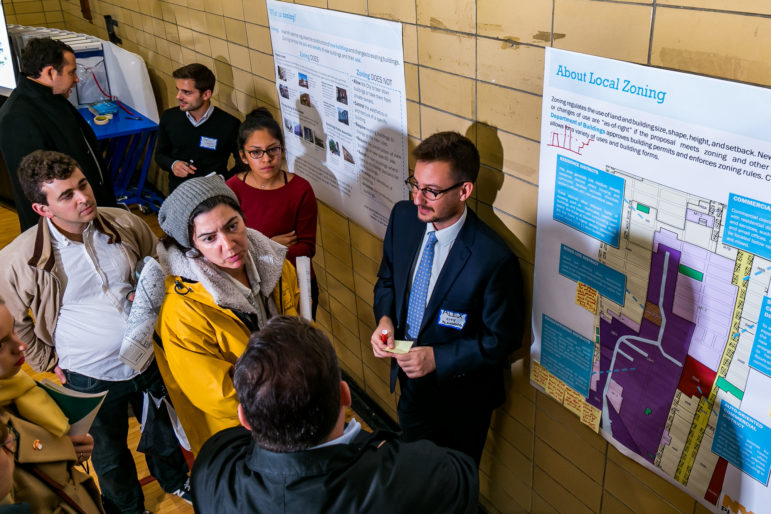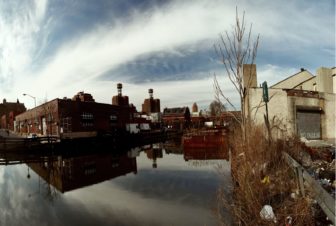
Adi Talwar
City officials emphasized that they are starting from scratch, not basing this new effort on the Bloomberg-era proposal that was dropped.
Gowanus stakeholders have been anticipating—and some, dreading—a city-initiated remaking of the Gowanus for almost a decade. One couldn’t help but sense some impatience for answers at Thursday night’s first city planning meeting, which launched the de Blasio administration’s study to craft a neighborhood plan for the community.
Department of City Planning officials emphasized that that the city did not yet have a rezoning proposal for the neighborhood and that a proposal would be shaped by conversations with the community in months to come.
“We are not starting from where we left off in 2009 and 2010,” said DCP project manager Jonathan Keller, referring to the agency’s prior zoning plan, which was scrapped in 2010 when the Gowanus was designated a Superfund site. That plan would have allowed residential development along the banks of the canal.
“A lot has changed in the neighborhood since then. …We really are taking a fresh look at all this,” Keller explained.
Keller did say, however, that DCP’s plan will find a strong basis in the Bridging Gowanus neighborhood process hosted by Councilman Brad Lander from 2013 to 2015, which involved hundreds of participants and articulated many community goals, but which some community members criticized as playing into the hands of developers because it too suggested some form of residential development, though with added measures to strengthen industry and create affordable housing.
In their presentation in PS 32’s auditorium, DCP affirmed the four goals that emerged from Bridging Gowanus: guaranteeing investments in infrastructure, strengthening manufacturing, creating a mixed-use canal, and creating and preserving affordable housing.
Translating these goals into their own language, DCP said its study aimed to improve the Gowanus streetscape, make the area more resilient, create and preserve affordable housing as well as new market-rate housing and provide jobs in industry, arts and culture.
As in other neighborhoods that have been studied for a rezoning by this administration, DCP will work with many sister agencies to craft a plan that addresses multiple aspects of community wellbeing.
DCP’s presentation broke down the neighborhood into four segments. First, the neighborhood has two large public housing developments, Gowanus Houses to the west of the canal and Wyckoff Gardens to the east. DCP said it hoped to connect residents of each with jobs and services, and would coordinate its planning process with the New York City Housing Authority, which is undergoing its own planning process at Wyckoff to lease land to a private developer for the construction of housing.
Second, DCP’s presentation said the canal north of Third Street and adjacent areas, currently mostly zoned for manufacturing, presented an opportunity for “a mix of uses including light-industrial, arts and cultural, and residential where appropriate.” Bridging Gowanus reached the same conclusion, though not everyone who participated agreed that the city should allow residential development, and even among those who conceded to housing growth, there was much disagreement about the extent—and the heights—at which it should be allowed.
Keller assured the audience that, “the study does not start from a presupposition that this [entire] area will be appropriate for residential.”
Third, the neighborhood south of Third Street now includes an Industrial Business Zone, which offers certain protections for manufacturing. DCP is interested in strengthening these protections, and promised the district would remain zoned for manufacturing, as requested by the final Bridging Gowanus report.
Fourth, DCP said that along Fourth Avenue, the subject of a 2003 rezoning, there were still opportunities for pedestrian improvements and affordable housing.
Under the city’s new mandatory inclusionary housing policy, 20 to 30 percent of any new housing generated by a rezoning would be rented at below-market rates.
Several attendees at the planning meeting wanted to ensure artistic and industrial uses would not be pushed out by luxury residential development.
“There’s no ability to have a live/work kind of situation,” said one artist. She and her husband bought a building in the area with the hopes of sustaining the area’s artistic and industrial culture. They would like to also live in that building to save money, but are not permitted under the city’s current manufacturing zoning. She is therefore supportive of some sort of mixed-use zoning that includes live/work spaces—but doesn’t want the area to become solely residential either.
“We’re just afraid that developers are going to come and try to persuade [our neighbors] to sell to them,” she told City Limits.
James Lang, a longtime resident, also wanted to know how DCP would protect existing industrial uses. “If you zone it for mixed use…you’re going to see that pressure to eliminate the manufacturing,” he warned a DCP planner.
(Some have ideas for how to preserve manufacturing in mixed-use districts. Lander has proposed a new zoning tool that he hopes will be able to ensure a true mixes of uses in the canal. And Councilman Levin mentioned a new program the city is piloting in Williamburg/Greenpoint to incentivize industrial uses.)
Other participants asked how vulnerable populations would stand to benefit from changes in the Gowanus. One mother said she wanted City Planning to make accessibility for disabled residents like her daughter an integral part of the design of new structures. A NYCHA resident wanted to know whether any of the profits generated from the rezoning would go to repairs in NYCHA buildings. Others noted the importance of ensuring that future meetings include the voices of a greater diversity of residents, including more NYCHA tenants, families who work on weeknights and non-English speakers.
“I don’t see a lot of people from my neighborhood here,” said Imani Gayle Gillison a founder of the Gowanus Canvassing Committee at Gowanus Houses, noting that many elder residents would not be able to easily walk around the open house and view the posters.
(Winston Von Engel, the director of Brooklyn’s DCP office, said that DCP would make an effort to be inclusive, hosting meetings on weekends and using translation services.)
Dave Powell, director of organizing at the Fifth Avenue Committee, was most concerned about the potential for the rezoning to trigger rent increases and displacement in the surrounding area.
“We are still reeling from the 2003 rezoning of [Fourth Avenue]. …We’ve watched dozen of tenants displaced from their homes and rent stabilized units lost,” Powell said. He called for both a separate study of displacement and for the city to adopt mitigate strategies like a special district requiring certificates of no-harassment. Powell was disappointed that, while DCP and HPD officials welcomed the feedback, they would not make promises of either.
“What tenants … are waiting to hear before they can believe in this process is some acknowledgement form the city that their crisis is real,” he said after the meeting.
Lander, for his part, urged the crowd to bring all their concerns and demands to the table for an ongoing discussion.
“There are going to be hard questions here and we’re going to have to go through them together because that’s the only way to do it,” he said. “The fact that we have City Planning meeting to kick it off with a dialogue about the process, about how people can engage, I’m encouraged.”
The next Gowanus planning meeting, focused on issues of resiliency and sustainability, will be held on Thursday December 8th, at a location to be determined.








